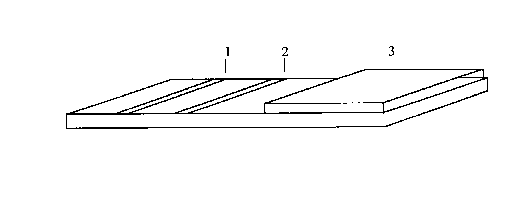Some of the information on this Web page has been provided by external sources. The Government of Canada is not responsible for the accuracy, reliability or currency of the information supplied by external sources. Users wishing to rely upon this information should consult directly with the source of the information. Content provided by external sources is not subject to official languages, privacy and accessibility requirements.
Any discrepancies in the text and image of the Claims and Abstract are due to differing posting times. Text of the Claims and Abstract are posted:
| (12) Patent Application: | (11) CA 2216189 |
|---|---|
| (54) English Title: | ONE-STEP SEMI-QUANTITATIVE/MULTIPLE ITEMS TEST KIT |
| (54) French Title: | TROUSSE DE MISES A L'ESSAI DEMI-QUANTITATIVE/ MULTIPLES SUBSTANCES NE COMPORTANT QU'UNE ETAPE |
| Status: | Deemed Abandoned and Beyond the Period of Reinstatement - Pending Response to Notice of Disregarded Communication |
| (51) International Patent Classification (IPC): |
|
|---|---|
| (72) Inventors : |
|
| (73) Owners : |
|
| (71) Applicants : |
|
| (74) Agent: | |
| (74) Associate agent: | |
| (45) Issued: | |
| (22) Filed Date: | 1997-11-12 |
| (41) Open to Public Inspection: | 1999-05-12 |
| Examination requested: | 2002-06-06 |
| Availability of licence: | N/A |
| Dedicated to the Public: | N/A |
| (25) Language of filing: | English |
| Patent Cooperation Treaty (PCT): | No |
|---|
| (30) Application Priority Data: | None |
|---|
In the field of medical diagnosis, determination of analytes such as hormones, proteins,
antibodies or antigens is very important to the diagnostic of medical status. Enzyme
immunoassay (EIA) and radioimmunoassay (RIA) are among the most common method
for quantifying such substances However, these methods are usually time consuming
and technically demanding, especial for small sample number. In this invention, an
inexpensive method of semi-quantifying the analyte in biological samples is invented.
This invention can also determine more than one analytes with a single test kit. The
device is using the principle of the one-step colloidal gold immunoassay for
semi-quantifying purpose. By comparing the color intensity of the built-in semi-quantitative
control with the test result, an estimated concentration of the analyte can be obtained.
Also, between each band, a visible marker line will be used to distinguish among bands.
This diagnostic kit with internal semi-quantitative capability may be used for fertility
tests, infectious diseases tests and other one step diagnostic tests.
Note: Claims are shown in the official language in which they were submitted.
Note: Descriptions are shown in the official language in which they were submitted.

2024-08-01:As part of the Next Generation Patents (NGP) transition, the Canadian Patents Database (CPD) now contains a more detailed Event History, which replicates the Event Log of our new back-office solution.
Please note that "Inactive:" events refers to events no longer in use in our new back-office solution.
For a clearer understanding of the status of the application/patent presented on this page, the site Disclaimer , as well as the definitions for Patent , Event History , Maintenance Fee and Payment History should be consulted.
| Description | Date |
|---|---|
| Inactive: IPC from MCD | 2006-03-12 |
| Application Not Reinstated by Deadline | 2004-03-16 |
| Inactive: Dead - No reply to s.30(2) Rules requisition | 2004-03-16 |
| Deemed Abandoned - Failure to Respond to Maintenance Fee Notice | 2003-11-12 |
| Inactive: Abandoned - No reply to s.30(2) Rules requisition | 2003-03-17 |
| Inactive: S.30(2) Rules - Examiner requisition | 2002-09-16 |
| Letter Sent | 2002-06-21 |
| All Requirements for Examination Determined Compliant | 2002-06-06 |
| Request for Examination Requirements Determined Compliant | 2002-06-06 |
| Request for Examination Received | 2002-06-06 |
| Inactive: Prior art correction | 1999-10-13 |
| Inactive: Compliance - Formalities: Resp. Rec'd | 1999-09-07 |
| Inactive: Incomplete | 1999-08-10 |
| Inactive: Delete abandonment | 1999-07-12 |
| Deemed Abandoned - Failure to Respond to Notice Requiring a Translation | 1999-06-09 |
| Inactive: Cover page published | 1999-05-21 |
| Application Published (Open to Public Inspection) | 1999-05-12 |
| Inactive: Incomplete | 1999-03-09 |
| Inactive: Correspondence - Formalities | 1999-03-02 |
| Inactive: IPC assigned | 1997-12-11 |
| Inactive: IPC assigned | 1997-12-11 |
| Inactive: First IPC assigned | 1997-12-11 |
| Classification Modified | 1997-12-11 |
| Inactive: Filing certificate - No RFE (English) | 1997-11-27 |
| Filing Requirements Determined Compliant | 1997-11-27 |
| Application Received - Regular National | 1997-11-26 |
| Abandonment Date | Reason | Reinstatement Date |
|---|---|---|
| 2003-11-12 | ||
| 1999-06-09 |
The last payment was received on 2002-06-06
Note : If the full payment has not been received on or before the date indicated, a further fee may be required which may be one of the following
Please refer to the CIPO Patent Fees web page to see all current fee amounts.
| Fee Type | Anniversary Year | Due Date | Paid Date |
|---|---|---|---|
| Application fee - small | 1997-11-12 | ||
| MF (application, 2nd anniv.) - small | 02 | 1999-11-12 | 1999-09-07 |
| 1999-09-07 | |||
| MF (application, 3rd anniv.) - small | 03 | 2000-11-13 | 2000-04-19 |
| MF (application, 4th anniv.) - small | 04 | 2001-11-13 | 2001-11-08 |
| Request for examination - small | 2002-06-06 | ||
| MF (application, 5th anniv.) - small | 05 | 2002-11-12 | 2002-06-06 |
Note: Records showing the ownership history in alphabetical order.
| Current Owners on Record |
|---|
| JIA BEI ZHU |
| Past Owners on Record |
|---|
| None |